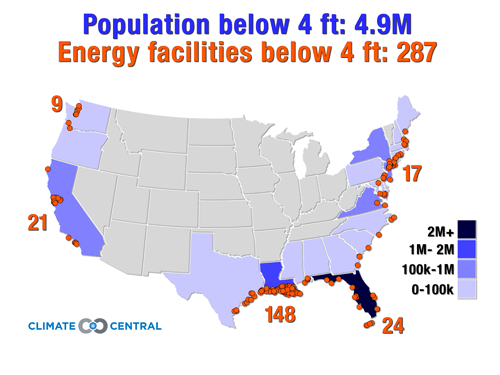Senate Testimony on Sea Level Rise by Climate Central’s Ben Strauss
Testimony for Senate Energy and Natural Resources Committee, April 19, 2012
Presented by Benjamin H. Strauss
New Report: Sea Level Rise Threatens Hundreds of U.S. Energy Facilities (PDF)
News: Senate Hearing Focuses on Threat of Sea Level Rise
Watch: Archived webcast of Senate hearing
Read: Senate testimony of five witnesses
Good morning, Senator Bingaman and colleagues. Thank you for your attention to this important topic. I am Dr. Ben Strauss, coauthor of two recent peer-reviewed papers making an assessment of sea level risk to the lower 48 states, as well as the summary report submitted with my written testimony. I am also Director of the Program on Sea Level Rise at Climate Central, a nonprofit research organization that conveys scientific information to the public. We take no policy positions.
In my testimony today, as in my research, I will address two topics: first, how sea level rise is amplifying the risk from coastal storm surges, and then, what communities and assets are exposed at the lowest elevations.
The nearest-term sea level projections I will share, in inches, may sound small. But they are dangerous. The key problem is that rising seas raise the launch pad for coastal storm surges, and tilt the odds toward disaster. Just a few extra inches could mean the difference to flood a family’s basement — or New York City’s subway system, disabling it for months. You might think of it this way: raising the floor of a basketball court would mean a lot more dunks.
 In the long term, we are likely to see many feet of sea level rise, and be forced to redraw the map of the United States. The high end of projections for this century would be enough to turn Miami-Dade County, Florida, into a collection of islands. But in the near term, we will mainly experience sea level rise as more and more coastal floods, reaching higher and higher.
In the long term, we are likely to see many feet of sea level rise, and be forced to redraw the map of the United States. The high end of projections for this century would be enough to turn Miami-Dade County, Florida, into a collection of islands. But in the near term, we will mainly experience sea level rise as more and more coastal floods, reaching higher and higher.
In fact, according to our analysis, sea level rise due to global warming has already doubled the annual risk of extreme coastal flooding across widespread areas of the nation. Global average sea level has risen about 8 inches since 1880. This means that warming is already contributing to the damage caused by any coastal flood today. Diverse studies bracket additional global rise likely this century between 1 and 7 feet.
In some areas, especially for Louisiana, Texas, and mid-Atlantic states, sinking land will add to the total effective rise and compound problems. Taking such local factors into account, we made mid-range projections for sites around the lower 48 of 1-to-8 total inches increase by 2030, and 4-to-19 inches by 2050, depending upon location. All along the Pacific, from Seattle to the Oregon coast to San Francisco to Los Angeles, the component of past and projected sea level rise from global warming more than triples the odds of “century” floods by 2030 in our analysis, as you can see from the display. The same is true inside the Chesapeake and Delaware Bays, and many sites to the north.
These increases are likely to cause a great deal of damage. At more than half the 55 sites where we studied flood risk, storm surges on top of sea level rise have better than even chances to reach more than 4 feet above the high tide line by 2030. Yet nearly 5 million U.S. residents live in 2.6 million homes on land below this level. Multiplied by the national average sales price of existing homes in 2010, this stock comes to more than $500 billion of residential real estate, in a rough estimate.
 An enormous amount of infrastructure also lies in the same zone, from airports to wastewater treatment plants, and including nearly 300 energy facilities — as you can see in the second display, along with population figures. The facilities shown are mainly natural gas, oil and gas, and electric facilities. More than half are in Louisiana, the vast majority there unprotected by levees.
An enormous amount of infrastructure also lies in the same zone, from airports to wastewater treatment plants, and including nearly 300 energy facilities — as you can see in the second display, along with population figures. The facilities shown are mainly natural gas, oil and gas, and electric facilities. More than half are in Louisiana, the vast majority there unprotected by levees.
In 285 municipalities, more than half the population lives on land below the 4-foot mark. One hundred and six of these places are in Florida and 65 are in Louisiana. In 676 towns and cities spread across every coastal state in the lower 48 except Maine and Pennsylvania, more than 10 percent of the population lives below the 4-foot mark. Maps and statistics for 3,000 coastal towns, cities, counties and states are searchable by name or zip code at sealevel.climatecentral.org, and I urge you and your colleagues and staff members to explore the places important to you.
In conclusion, the risks from sea level rise are imminent and serious; this is not a distant problem only of concern for our children. Escalating floods from sea level rise will affect millions of Americans, and threaten countless billions of dollars of damage to buildings and infrastructure.
Thank you for your attention.